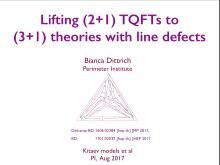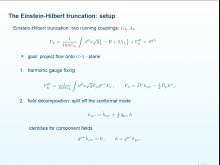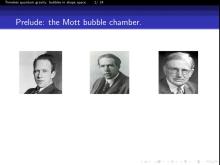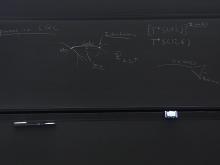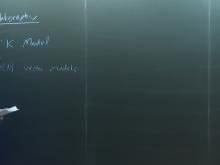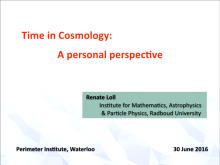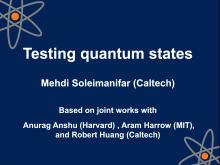Quantum gravity is concerned with unifying Einstein's general theory of relativity with quantum theory into a single theoretical framework. At Perimeter Institute, researchers are actively pursuing a number of approaches to this problem including loop quantum gravity, spin foam models, asymptotic safety, emergent gravity, string theory, and causal set theory. We are also particularly interested in experimental implications of these different proposals. As the aim is a unification of the laws of physics into a single theory, the search for quantum gravity overlaps with other areas such as cosmology, particle physics and the foundations of quantum theory.
Format results
-
34 talks-Collection NumberC17055
Talk
-

Quantifying the evidence for black holes with GW and EM probes
Paolo Pani Instituto Superior Tecnico - Departamento de Física
-

Echoes from the Abyss: Tentative Evidence for Planck-Scale Structure at Black Hole Horizons
Jahed Abedi University of Stavanger (UiS)
-

Improvements on the methods for searching echoes
Julian Westerweck Albert Einstein Institute
-

A model-independent search for gravitational-wave echoes
Archisman Ghosh Institucio Catalana de Recerca I Estudis Avancats (ICREA) - Universitat de Barcelona
-

An alternative significance estimation for the evidence for echoes
Alex Nielsen Albert Einstein Institute
-

Discussion: Evidence for Echoes
PIRSA:17110074 -

Inspiral Tests of Strong-field Gravity and Ringdown Tests of Quantum Black Holes
Kent Yagi University of Virginia
-

A Recipe for Echoes
Aaron Zimmerman The University of Texas at Austin
-
-
Talk
-

Semisimple Hopf algebras and fusion categories
Cesar Galindo Universidad de los Andes
-

The Hopf C*-algebraic quantum double models - symmetries beyond group theory
Andreas Bauer Freie Universität Berlin
-

Modular categories and the Witt group
Michael Mueger Radboud Universiteit Nijmegen
-

Topological Quantum Computation
Eric Rowell Texas A&M University
-

Gapped phases of matter vs. Topological field theories
Davide Gaiotto Perimeter Institute for Theoretical Physics
-

An Introduction to Hopf Algebra Gauge Theory
Derek Wise University of Erlangen-Nuremberg
-

Kitaev lattice models as a Hopf algebra gauge theory
Catherine Meusburger University of Erlangen-Nuremberg
-

Topological defects and higher-categorical structures
Jurgen Fuchs Karlstad University
-
-
Making Quantum Gravity Computable
31 talks-Collection NumberC17023Talk
-

Welcome and Opening Remarks
Bianca Dittrich Perimeter Institute for Theoretical Physics
-

Introduction to Monte Carlo methods - 1
Gerard Barkema Utrecht University
-

Introduction to Monte Carlo methods - 2
Gerard Barkema Utrecht University
-

Introduction to Tensor Network methods - 1
Guifre Vidal Alphabet (United States)
-

Introduction to Tensor Network methods - 2
Guifre Vidal Alphabet (United States)
-

Tutorial: Introduction to Monte Carlo Methods
-
Gerard Barkema Utrecht University
-
Nilas Klitgaard Radboud Universiteit Nijmegen
-
-

Tutorial: Introduction to Tensor Network methods
-
Guifre Vidal Alphabet (United States)
-
Clement Delcamp Institut des Hautes Etudes Scientifiques (IHES)
-
-

Scientific Computing and Computational Science
Erik Schnetter Perimeter Institute for Theoretical Physics
-
-
Shape Dynamics Workshop
16 talks-Collection NumberC17015Talk
-

Shape Dynamics: Perspectives and Problems
Julian Barbour University of Oxford
-

The quantum equation of state of the universe produces a small cosmological constant
Tim Koslowski Technical University of Applied Sciences Würzburg-Schweinfurt
-

Inflationary and pre-inflationary dynamics with the Starobinsky potential
Beatrice Bonga Radboud Universiteit Nijmegen
-

Relationalism and the speed of light: Are we in a relationship?
Yuri Bonder Universidad Nacional Autónoma De Mexico (UNAM)
-

Compact spherically symmetric solutions and gravitational collapse in SD
Flavio Mercati University of Naples Federico II
-

Self-gravitating fluid solutions of Shape Dynamics
Daniel Guariento Conestoga College
-

A Weyl-Type Theorem in Geometrized Newtonian Gravity, and How It May Bear on Shape Dynamics
Erik Curiel Ludwig-Maximilians-Universität München (LMU)
-

-
-
PSI 2016/2017 - Explorations in Quantum Gravity (Dupuis)
15 talks-Collection NumberC17010Talk
-

PSI 2016/2017 - Explorations in Quantum Gravity - Lecture 1
Maïté Dupuis Perimeter Institute for Theoretical Physics
-

PSI 2016/2017 - Explorations in Quantum Gravity - Lecture 2
Maïté Dupuis Perimeter Institute for Theoretical Physics
-

PSI 2016/2017 - Explorations in Quantum Gravity - Lecture 3
Maïté Dupuis Perimeter Institute for Theoretical Physics
-

PSI 2016/2017 - Explorations in Quantum Gravity - Lecture 4
Maïté Dupuis Perimeter Institute for Theoretical Physics
-

PSI 2016/2017 - Explorations in Quantum Gravity - Lecture 5
Maïté Dupuis Perimeter Institute for Theoretical Physics
-

PSI 2016/2017 - Explorations in Quantum Gravity - Lecture 6
Maïté Dupuis Perimeter Institute for Theoretical Physics
-

PSI 2016/2017 - Explorations in Quantum Gravity - Lecture 7
Maïté Dupuis Perimeter Institute for Theoretical Physics
-

PSI 2016/2017 - Explorations in Quantum Gravity - Lecture 8
Maïté Dupuis Perimeter Institute for Theoretical Physics
-
-
It from Qubit Summer School
62 talks-Collection NumberC16003Talk
-

-

Gravity Basics - 1
Veronika Hubeny University of California, Davis
-

QI Basics - 1
Patrick Hayden Stanford University
-

Entanglement - 1
Robert Spekkens Perimeter Institute for Theoretical Physics
-

GR: Actions and Equations
David Kubiznak Charles University
-

A new perspective on holographic entanglement
Matthew Headrick Brandeis University
-

Bell’s Theorem
Adrian Kent University of Cambridge
-

QI Basics - 2
John Watrous IBM (Canada)
-
-
Time in Cosmology
14 talks-Collection NumberC16016Talk
-

Welcome and Opening Remarks
-
Marina Cortes Institute for Astrophysics and Space Sciences
-
Lee Smolin Perimeter Institute for Theoretical Physics
-
Neil Turok University of Edinburgh
-
-

-

The origin of arrows of time II
-
Sean Carroll California Institute of Technology (Caltech) - Division of Physics Mathematics & Astronomy
-
Marina Cortes Institute for Astrophysics and Space Sciences
-
Tim Koslowski Technical University of Applied Sciences Würzburg-Schweinfurt
-
-

The origin of arrows of time II cont.
-
Sean Carroll California Institute of Technology (Caltech) - Division of Physics Mathematics & Astronomy
-
Marina Cortes Institute for Astrophysics and Space Sciences
-
Tim Koslowski Technical University of Applied Sciences Würzburg-Schweinfurt
-
-

Testing time asymmetry in the early universe
-
Brian Keating University of California, San Diego
-
Andrew Liddle University of Lisbon
-
Richard Muller University of California, Berkeley
-
-

The fate of the big bang
-
Abhay Ashtekar Pennsylvania State University
-
Neil Turok University of Edinburgh
-
-

Time as Organization – Downward Caustation, Structure and Complexity I
Barbara Drossel Technische Universität Darmstadt
-

Time as Organization – Downward Caustation, Structure and Complexity II
-
Stuart Kauffman Santa Fe Institute
-
George Ellis University of Cape Town
-
-
-
Quantum Information in Quantum Gravity II
31 talks-Collection NumberC15041Talk
-

Gravity Dual of Quantum Information Metric
Tadashi Takayanagi Yukawa Institute for Theoretical Physics
-

A new perspective on holographic entanglement
Matthew Headrick Brandeis University
-

Universal holographic description of CFT entanglement entropy
Thomas Faulkner University of Illinois Urbana-Champaign
-

Geometric Constructs in AdS/CFT
Veronika Hubeny University of California, Davis
-

Do black holes create polyamory
Jonathan Oppenheim University College London
-

Tensor Network Renormalization and the MERA
Glen Evenbly Georgia Institute of Technology
-

Entanglement renormalization for quantum fields
Jutho Haegeman Ghent University
-

Holographic quantum error-correcting codes: Toy models for the bulk/boundary correspondence
Fernando Pastawski California Institute of Technology
-
-

On the reconstruction map in JT gravity
Chris Akers Massachusetts Institute of Technology (MIT)
-

Canonical purifications revisited
Jonathan Sorce Massachusetts Institute of Technology (MIT)
-

Does connected wedge imply distillable entanglement?
Takato Mori Rikkyo University
-

Baby Universes and Holography II: Observer Complementarity
Elliott Gesteau California Institute of Technology (Caltech)
-
Quantum Black Holes in the Sky?
34 talks-Collection NumberC17055The past decade has witnessed significant breakthroughs in understanding the quantum nature of black holes, with insights coming from quantum information theory, numerical relativity, and string theory. At the same time, astrophysical and gravitational wave observations can now provide an unprecedented window into the phenomenology of black hole horizons. This workshop seeks to bring together leading experts in these fields to explore new theoretical and observational opportunities and synergies that could improve our physical understanding of quantum black holes.
-
Hopf Algebras in Kitaev's Quantum Double Models: Mathematical Connections from Gauge Theory to Topological Quantum Computing and Categorical Quantum Mechanics
18 talks-Collection NumberC17029The Kitaev quantum double models are a family of topologically ordered spin models originally proposed to exploit the novel condensed matter phenomenology of topological phases for fault-tolerant quantum computation. Their physics is inherited from topological quantum field theories, while their underlying mathematical structure is based on a class of Hopf algebras. This structure is also seen across diverse fields of physics, and so allows connections to be made between the Kitaev models and topics as varied as quantum gauge theory and modified strong complementarity. This workshop will explore this shared mathematical structure and in so doing develop the connections between the fields of mathematical physics, quantum gravity, quantum information, condensed matter and quantum foundations.
-
Making Quantum Gravity Computable
31 talks-Collection NumberC17023Making Quantum Gravity Computable
-
-
PSI 2016/2017 - Explorations in Quantum Gravity (Dupuis)
15 talks-Collection NumberC17010PSI 2016/2017 - Explorations in Quantum Gravity (Dupuis) -
-
-
Quantum Information in Quantum Gravity II
31 talks-Collection NumberC15041Quantum Information in Quantum Gravity II -

On the reconstruction map in JT gravity
Chris Akers Massachusetts Institute of Technology (MIT)
A key question in holography is how to reconstruct bulk operators in the holographic dual. It is especially interesting to reconstruct operators inside the black hole interior, but also especially difficult to do explicitly. Recently, an explicit form for the bulk-to-boundary `holographic’ map was proposed in JT gravity, by Iliesiu, Levine, Lin, Maxfield, and Mezei, who also proposed and studied an explicit `reconstruction’ map on operators. In this talk, I will discuss various pros and cons of their reconstruction map, and propose an alternative map with perhaps nicer properties. -

Canonical purifications revisited
Jonathan Sorce Massachusetts Institute of Technology (MIT)
I will use algebras to revisit and generalize the theory of canonical purifications, explain the general concept of "CRT sewing without gravity," and explain how this technology allows the influential-but-complicated "Araki-Yamagami theorem" from the '80s to be proved with 10x less work using a QI-motivated trick. Based on work with Caminiti and Capeccia. -

Does connected wedge imply distillable entanglement?
Takato Mori Rikkyo University
In holography, when two boundary subsystems have large mutual information, they are connected by their entanglement wedge. However, it remains mysterious whether these subsystems are EPR-like entangled. In this talk, I resolve this problem by finding bulk duals of one-shot distillable entanglement. Namely, I show that in one-shot scenarios: i) there is no distillable entanglement only by local operations at leading order in $G_N$, suggesting the absence of bipartite entanglement in a holographic mixed state, and ii) one-way LOCC-distillable entanglement is related to the entanglement wedge cross section, which is further dual to entanglement of formation. By demonstrating an explicit distillation protocol by holographic measurements, I conclude that a connected wedge does not necessarily imply finite distillable entanglement even when one-way LOCC is allowed. This talk is based on arXiv:2411.03426 [hep-th] and 2502.04437 [quant-ph]. -

Baby Universes and Holography II: Observer Complementarity
Elliott Gesteau California Institute of Technology (Caltech)
The notion of complementarity, first introduced in the context of the information paradox, posits that the experiences of two observers who cannot communicate need not match in quantum gravity. In the context of the previous talk, I will argue that the recent proposals for explicitly taking observers into account provide a way to describe semiclassical closed universes in holography, at the expense of a resort to complementarity. I will then discuss an analogous setup in the case of an evaporating black hole, and propose a set of general principles for black hole complementarity. This talk is based on an ongoing collaboration with Netta Engelhardt and Daniel Harlow.
